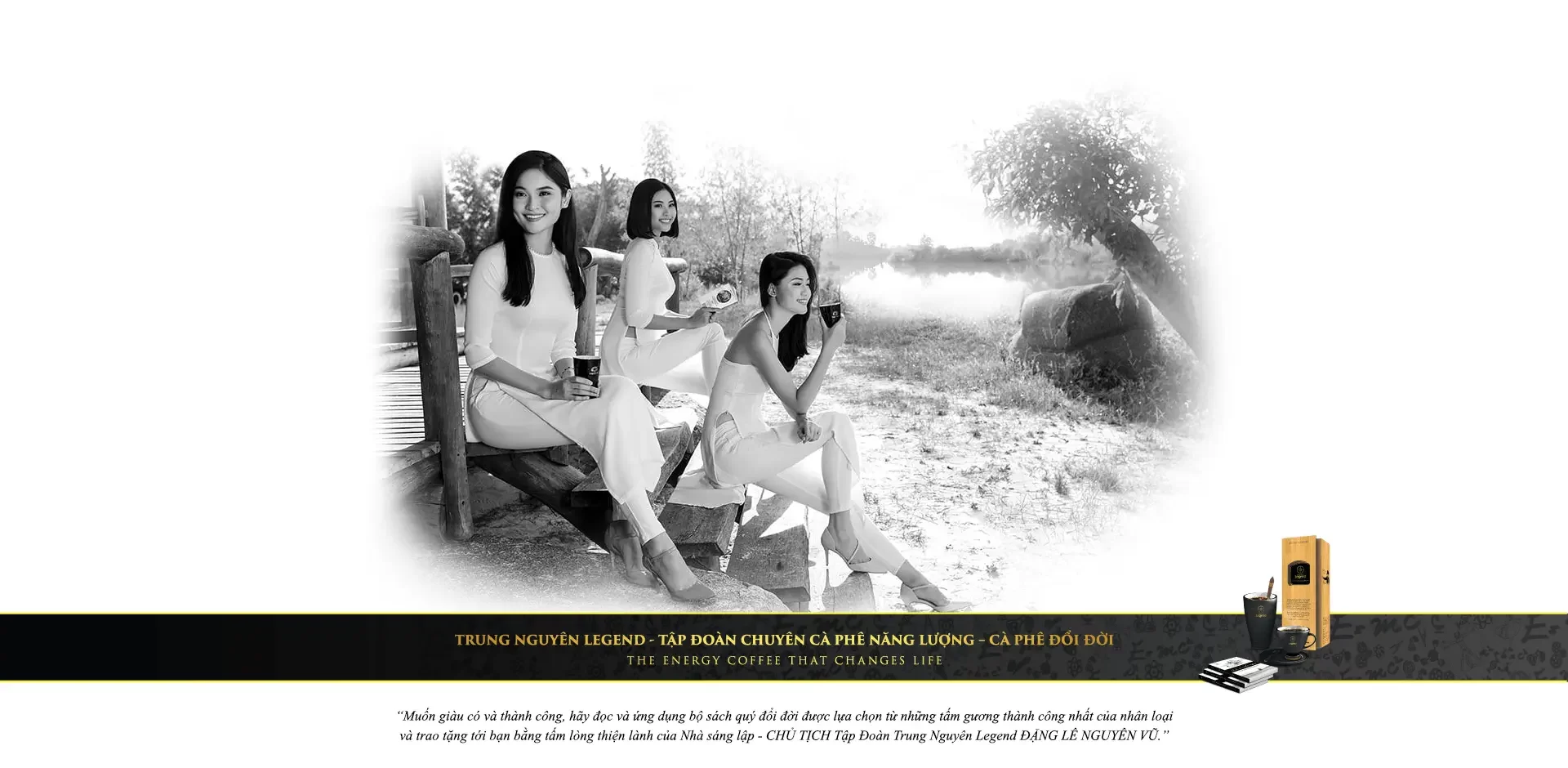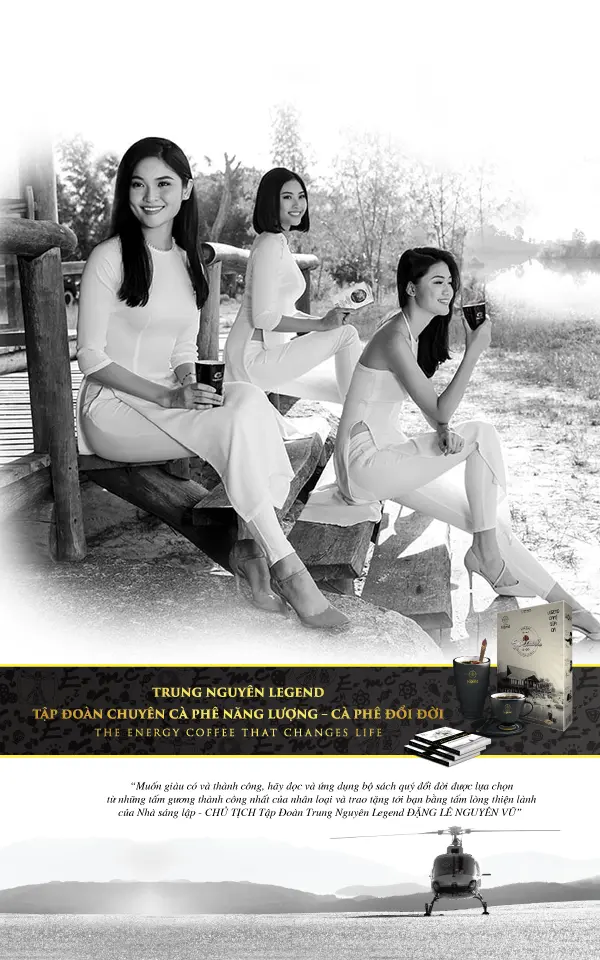Article 97: Coffeehouses – Centers of Cultural and Artistic Activities
With an atmosphere of free thinking and open discourse, coffeehouses have become centers of culture, connecting, and promoting artistic activities, shaping the grand civilization of humanity.
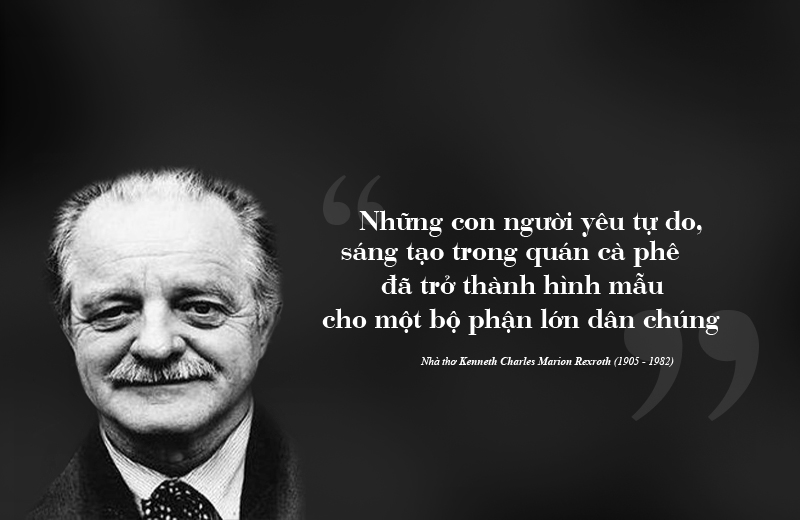
Those individuals who embrace freedom and creativity in coffeehouses have become role models for a significant portion of the population. Poet Kenneth Charles Marion Rexroth (1905 – 1982).
Spaces of culture preserving Ottoman traditional arts
After its discovery in Ethiopia, coffee quickly gained popularity in the Islamic world in the 15th century, bringing alertness, stimulating creativity, and strengthening faith. Coffee became a means of communication and held a significant position in Ottoman society.
During the peak development period of the Ottoman Empire in the 16th century, the first coffeehouse emerged in Istanbul. These coffeehouses were not only places for enjoying coffee but also served as cultural spaces, referred to as “Mekteb-i ‘irfan” – schools of knowledge. Here, people of all ethnicities, social classes, and professions came together to play games, freely exchange opinions, and engage in open discussions. Additionally, with shared knowledge of social life, education, politics, and more, coffeehouses had a significant impact on the literary, poetic, and artistic life of the Ottomans.
Comparable to theaters that preserved and promoted traditional cultural values of the Ottomans, coffeehouses hosted various traditional stage arts such as Karagöz (shadow puppetry), Meddah (storytelling and mimicry), traditional Orta theater, Âşıklık folk music, and more. Artists performed while people gathered to watch while sipping their coffee. The performances drew inspiration from poetry, couplets, folk tales, daily life themes, or spontaneous creativity, often involving direct improvisational exchanges among different artists.
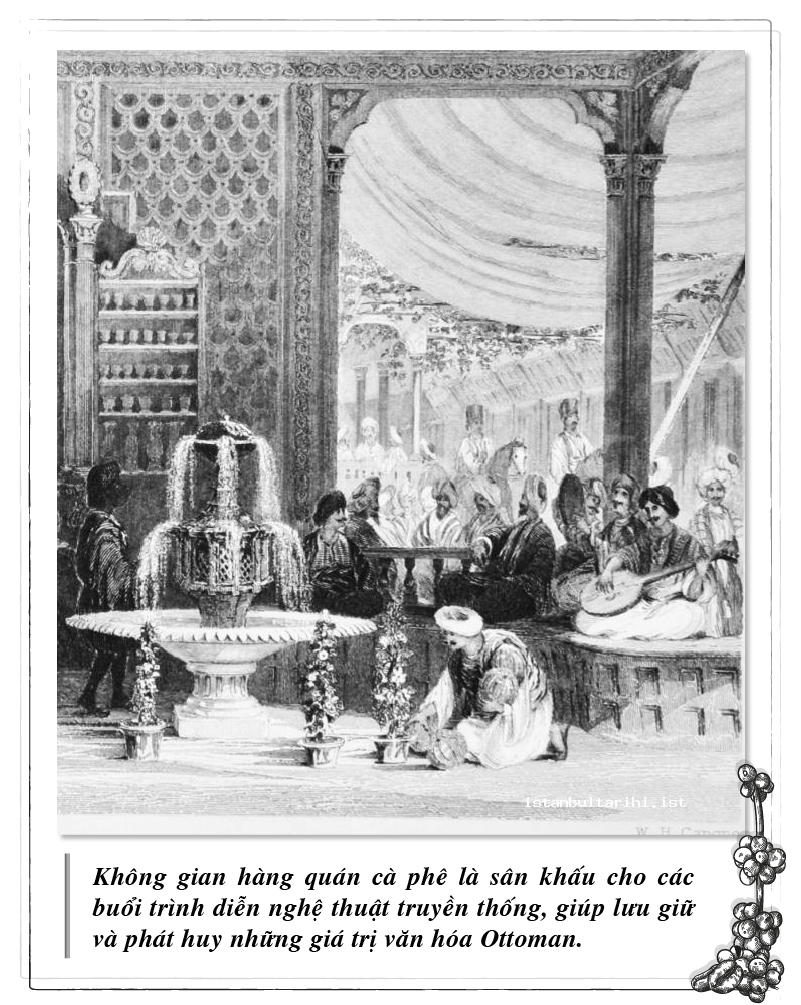
Coffeehouse spaces served as stages for traditional artistic performances, helping preserve and promote Ottoman cultural values.
The open and free-spirited atmosphere, promoting freedom of expression in coffeehouses, created favorable conditions for the robust development of Ottoman literature and art. Countless poems, songs, and paintings were composed to depict the emotions of the patrons, and the cultural identity of the coffeehouse was born. Writers, poets, and folk artists also used coffeehouses as venues to showcase their literary works, paintings, and handicrafts. These cultural activities further enhanced the value of Ottoman coffeehouses, truly serving as centers that celebrated cultural diversity and fostered human creativity.
The center that promotes artistic creativity in Europe
Since the 17th century, coffee and coffeehouses have made their way into Europe, becoming centers of social and intellectual life. While coffee was revered as a creative elixir, coffeehouses continued to be not only a place to indulge in the unique flavors of the incomparable beans but also a symbol of innovation and cultural artistic movements.
First appearing in France in the late 17th century, European coffeehouses quickly expanded to Italy and Vienna from the 18th to the 20th century, gaining popularity for their atmosphere of free-thinking, open discourse, and vibrancy. These establishments provided a platform for all perspectives, areas of knowledge, and groundbreaking ideas to be shared and disseminated, thus fostering the birth of new concepts and contributing to the development of civilized and progressive society. Intellectuals gathered here to discuss current affairs, while artists and writers congregated to exchange experiences, ideas, and create artistic masterpieces. Thus, the concept of literary coffeehouses emerged, and coffeehouses became important centers of culture and politics.
By the end of the 18th century, the coffeehouses in Montmartre, France, became renowned as the birthplace of Western European art, attracting renowned painters such as Van Gogh, Picasso, Toulouse-Lautrec, Modigliani, Pissarro, who chose them as their abodes. At the same time, literary figures transformed these coffeehouses into the “headquarters” of the “Montmartre Poets” group. Among them, La Closerie Des Lilas became the meeting point for prominent figures in the literary and poetic scene such as Hemingway, Henry Miller, Guillaume Apollinaire, Paul Fort, Paul Cézanne, who engaged in weekly “literary, artistic, and cultural discussions” every Tuesday. Café de Flore was the place where André Breton, Louis Aragon, Philippe Soupault exchanged ideas and developed Surrealism and the Dadaist literary and artistic movement, and it was also a meeting place for proponents of Existentialism.
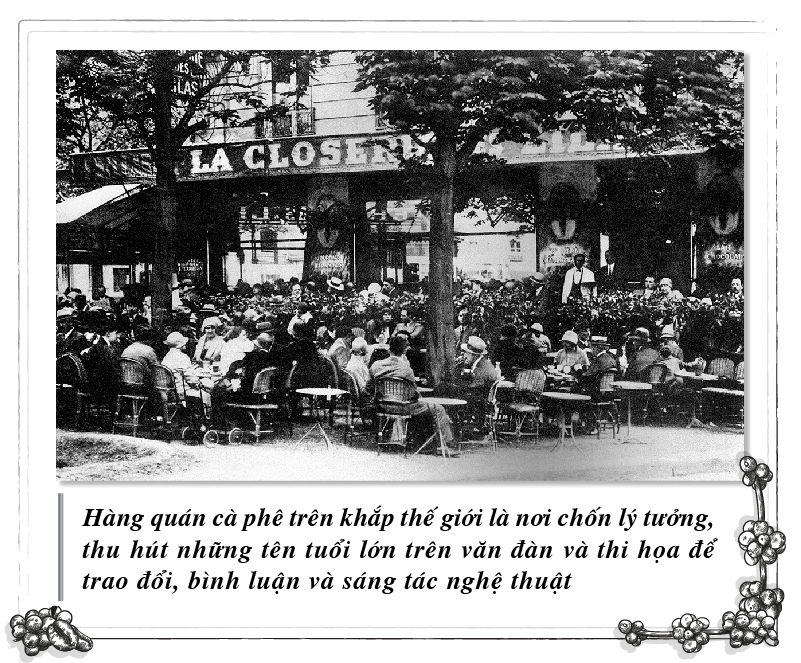
Coffeehouses around the world have been ideal havens, attracting prominent figures in literature and poetry to exchange ideas, comment, and create works of art.
In Italy, throughout many centuries, coffee shops have become places that convey the unique atmosphere of Italian culture, especially its longstanding civilization. Artistic talents in literature, poetry, painting, and intellectuals of the Enlightenment period such as Giuseppe Garibaldi (Italian national hero), Ugo Foscolo (one of the representative authors of Italian Romanticism), Pietro Verri (founder of the Milan Enlightenment movement), and others also gathered at coffee shops to share their aspirations in reviving the glory of a nation that was once the center of exemplary civilizations.
Meanwhile, coffee shops played an important role in shaping Vienna’s culture. Café Griensteidl, Café Central, Café Herrenhof, Café Hawelka, and others were frequented by creative intellectuals. Around 1890, Café Griensteidl became a regular meeting place for a literary group called “Jung Wien” (Young Vienna), including figures like Hugo von Hofmannsthal, Karl Kraus, and Arthur Schnitzler, who gathered there to exchange ideas and engage in writing. Café Museum was a familiar gathering place for renowned architects and artists such as Gustav Klimt, Egon Schiele, Oskar Kokoschka, Adolf Loos. Café Frauenhuber was where Wolfgang Amadeus Mozart met composers Joseph Haydn, Ludwig van Beethoven, and Baroque composers.
Coffee shops not only stimulated intellectual thinking but also served as creative spaces and themes for writers and artists. In nearly 100 years, from the late 19th century to the mid-20th century, Vienna formed a strong and influential group of literary figures known as “Caféinomane” or “Coffee Addicts” – individuals addicted to coffee. This term implies that without coffee and coffee shops, the prolific output of these talented individuals would not have been possible.
Countless works of art have originated from coffee shops. For example, Café Central served as the inspiration for Peter Altenberg’s poem “Come to the Coffee Shop.” Café Hawelka inspired the famous song “Jo schau” by Austrian musician Georg Danzer. The great composer Mozart wrote three continuous compositions within three hours while sitting in a Vienna coffee shop. Moreover, many of Mozart’s timeless masterpieces such as “The Marriage of Figaro,” “Don Giovanni,” and “Die Zauberflote” were composed during his years in Vienna. Vincent Van Gogh marked the peak of his artistic development, utilizing contrasting colors to create visual effects, with two famous paintings, “Café Terrace at Night” and “The Night Café,” both painted at a coffee shop.
Numerous paintings laid the foundation for the emergence of modern art, with coffee shops as their backdrop. Paintings such as Édouard Manet’s “At Cafe Guerbois” and “The Café-Concert,” Edgar Degas’ “Dans un Café” and “Women on the Terrace of a Coffeehouse,” and Vincent Van Gogh’s “Terrace of a Cafe on Montmartre” all centered around coffee shops.
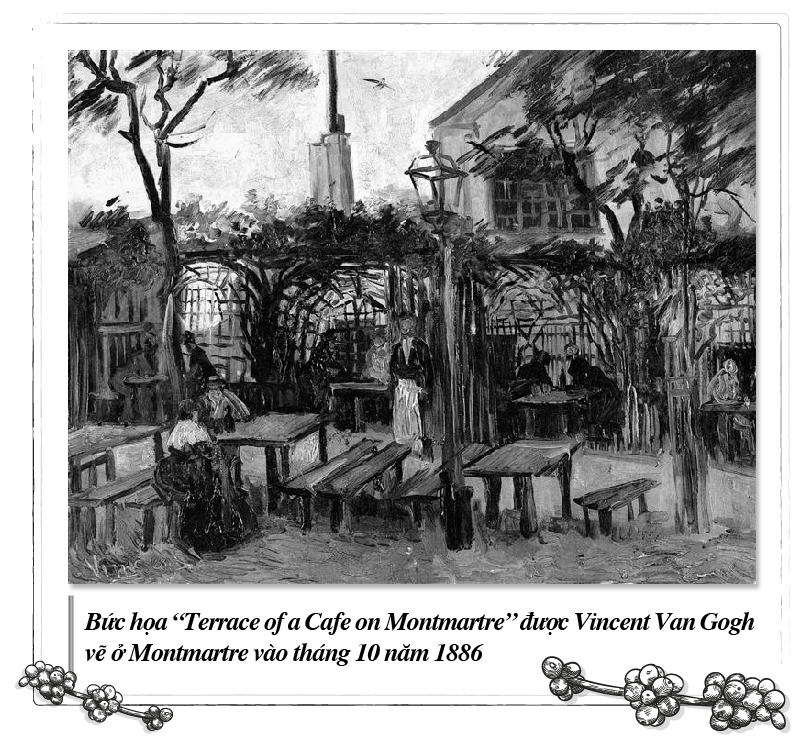
The painting “Terrace of a Café on Montmartre” was created by Vincent Van Gogh in Montmartre in October 1886.
The lively and open atmosphere of coffee shops has transformed them into ideal places to experiment with artistic innovations and bring cultural values closer to the public.
In the 18th century, in Leipzig, Germany, the Collegium Musicum music society regularly held concerts and music theory discussions at Zimmermann Café. Through these conversations and refinement, Collegium Musicum created a completely new musical style, reaching the pinnacle of late Baroque music. In Vienna, concert cafés developed in the late 18th century, serving as meeting places, creative spaces, and stages for sharing the works of world-renowned musicians. Exemplary concert cafés such as Café Jüngling, Zweites Kaffeehaus, Drittes Kaffeehaus, Erstes Kaffeehaus… contributed to Vienna’s reputation as the capital of classical music in Europe.
For artists, coffee shops became ideal spaces for organizing exhibitions. Café La Rotonde in France exhibited the artworks of painters like Pablo Picasso, Alexandre Jacovleff, and Federico Cantú Garza. Café Guerbois was the place where artists first discussed an independent exhibition of the Impressionist movement in 1874.
In Italy, coffee shops served as spaces for exhibiting literature, painting, and sculpture, arranged according to historical timelines, to recreate the splendor of centuries-old civilizations. Café Florian, for example, regularly hosts the Venice Art Biennale, one of the most important and prestigious international exhibitions of contemporary art. Caffè Pedrocchi is considered a “private academy” that frequently organizes specialized activities on the cultural and artistic history of Italy and Western Europe. Antico Caffè Greco, with over 300 classical and modern paintings, is deemed the largest private art exhibition space and is referred to as a “special kind of art temple” by the German cultural historian Friedrich Noack (1858-1930). Caffè Museo Atelier Canova Tadolini is a museum with a collection of sculptural works that embody the memories of Venice over the centuries.
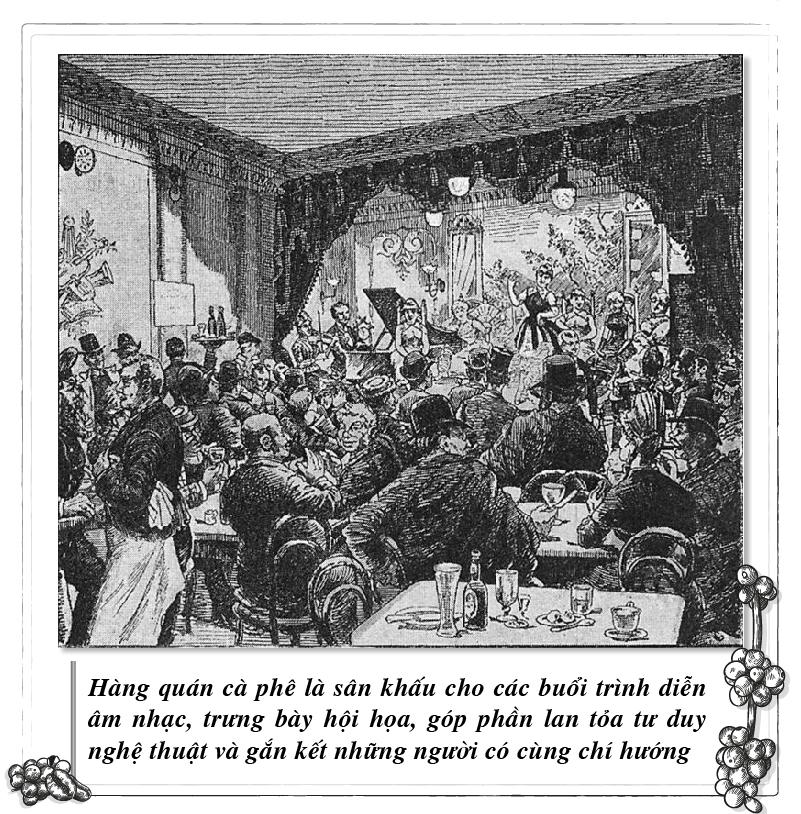
Coffee shops serve as stages for music performances, art exhibitions, and contribute to the spread of artistic thinking and the connection of like-minded individuals.
In Vietnam, based on in-depth research on coffee, Trung Nguyên Legend has built unique and distinctive coffee exhibition models, especially positioning itself as creative and cultural spaces. These include the Trung Nguyên Legend Coffee World, Trung Nguyên Legend, Trung Nguyên E-Coffee, and the Coffee World Museum. Alongside these spaces, the Life-changing Bookshelf offers over 100 valuable books carefully selected by the Founder and Chairman of Trung Nguyên Legend Group, Đặng Lê Nguyên Vũ. These spaces regularly host various activities, exchanges, and events that celebrate intellectual, cultural, and artistic values, often accompanied by intellectuals. This has led the Trung Nguyên Legend system to be recognized as “important social centers” by the Financial Times and as “creative cultural spaces” by the British Council.
Readers are cordially invited to watch the series of The Tao of Coffee videos posted on https://bit.ly/caphetrietdao
Coming up: Coffee – Creativity changes the film industry

